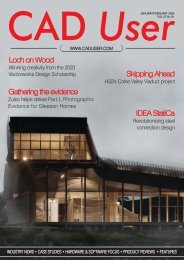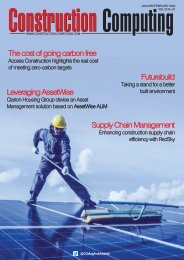DM1907
Create successful ePaper yourself
Turn your PDF publications into a flip-book with our unique Google optimized e-Paper software.
Dm MANAGEMENT: INTELLIGENT AUTOMATION<br />
Beyond Robotic Process Automation<br />
Intelligent Automation offers the next step to 'working like tomorrow, today', argues<br />
Chris Huff, Chief Strategy Officer, Kofax<br />
Businesses of all sizes rely on an<br />
assortment of processes to get things<br />
done and achieve organisational<br />
goals. New customer onboarding, financial<br />
reporting, batch processing, and shipment<br />
scheduling and tracking are just a few<br />
examples. If handled quickly and efficiently,<br />
they deliver meaningful benefits that<br />
impact revenue and growth, including<br />
enhanced service levels, lower operational<br />
costs, and higher customer satisfaction. It's<br />
also true that these processes - often paperbased<br />
and manual - are excellent<br />
candidates for automation.<br />
To be sure, many companies have<br />
implemented robotic process automation<br />
(RPA) within pockets of their organisation.<br />
But even in the digital era, a large share<br />
have yet to implement RPA even for<br />
optimised processes, and even fewer to<br />
automate end-to-end using intelligent<br />
automation. A global Forbes Insights survey<br />
found a quarter of processes are still<br />
completely or mostly manual, and another<br />
37% are a mix of manual and automated.<br />
That there is still significant room for<br />
automation through the enterprise is hardly<br />
in dispute. In fact, nine out of 10 executives<br />
say they recognise its importance to their<br />
future success. And those that have started<br />
their transformation by implementing RPA<br />
technology, which uses software robots to<br />
automate routine, manual tasks, are seeing<br />
efficiency and productivity gains.<br />
The real opportunity, though, is to move<br />
beyond RPA to intelligent automation. This<br />
next generation technology - bringing<br />
together capabilities such as process<br />
orchestration, cognitive capture, and<br />
advanced analytics - is the only way to drive<br />
maximum business value.<br />
Thus, the true "next step" for the enterprise<br />
of the future isn't automating in small<br />
pockets with point solutions. Instead, it's<br />
implementing intelligent automation across<br />
the enterprise. This approach checks the<br />
box on every C-suite goal: time and cost<br />
savings, improved collaboration, higher<br />
employee satisfaction and a better<br />
customer experience.<br />
WHERE THE OPPORTUNITIES ARE<br />
But where do businesses start? How do<br />
they identify the most promising places<br />
within their organisation to extend<br />
automation capabilities? The Forbes<br />
Insights survey uncovered opportunities in<br />
three key areas.<br />
1. Document and data processing:<br />
Accounts payable, legal and sales teams are<br />
often unnecessarily burdened with<br />
document-heavy processes. But when<br />
invoices, contracts and sales and purchase<br />
orders are handled manually, errors and<br />
delays occur, leading to higher costs and<br />
missed payments. According to the Forbes<br />
Insight survey, just 13% of companies say<br />
they've fully automated the interpretation<br />
of unstructured content, while one-quarter<br />
simply turn text over to humans. Other<br />
organisations say their firms fall somewhere<br />
in between, with automation ranging from<br />
keyword extraction to sentiment analysis.<br />
Of course, manual processing of large<br />
volumes of documents isn't sustainable or<br />
desirable in a world where consumers value<br />
speed and experience most. Businesses<br />
need employees to focus on higher-value,<br />
customer-oriented tasks, and no one has<br />
time for bottlenecks. One way to transform<br />
this situation is to implement RPA with<br />
integrated intelligent optical character<br />
recognition (OCR). This technology creates<br />
a complete workflow that automates<br />
document-heavy processes, making them<br />
faster and more reliable while also giving<br />
employees more time to attend to<br />
customer needs.<br />
2. Automating tasks into an end-to-end<br />
sequence: Businesses so far have<br />
automated processes in discrete corners<br />
6 @DMMagAndAwards July/August 2019 www.document-manager.com

















